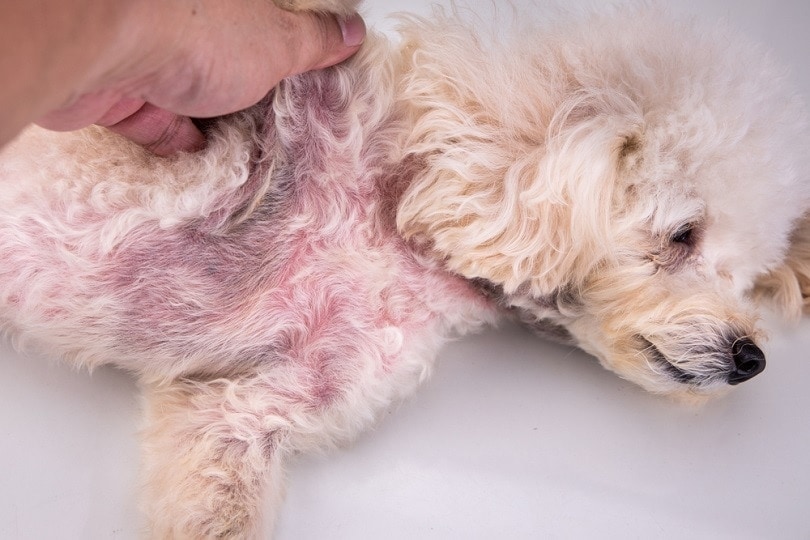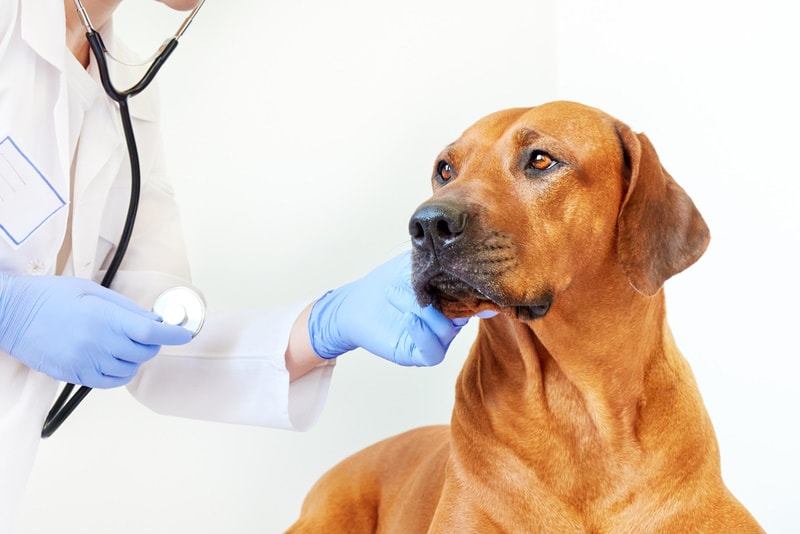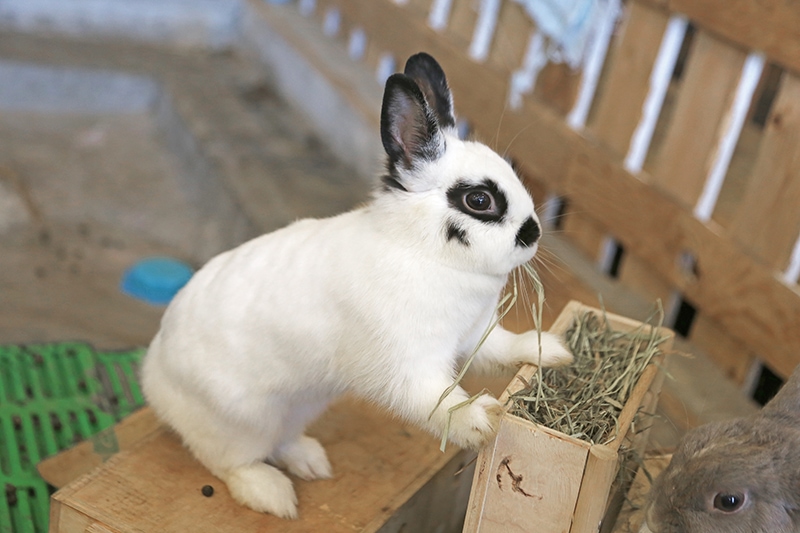Yeast Infections In Dogs: Cause, Signs & Care (Vet Answer)

Updated on

Does your dog have itchy, inflamed skin and a musty odor? Or have you noticed a brown discharge coming from his ears? If so, your dog may have a yeast infection. A yeast infection, also known as yeast dermatitis or Malassezia dermatitis, is a common cause of skin disease in dogs. Lets discussed yeast dermatitis in more detail including it’s causes, signs to look out for, and ways to care for your dog if he has a yeast infection.
What Is a Yeast Infection?
A yeast infection, also known as yeast dermatitis or Malassezia dermatitis, is an inflammatory condition associated with increased numbers of Malassezia yeasts on the skin. The condition is caused by the fungus Malassezia pachydermatis. Malassezia are budding, spore-like fungi that are part of the normal fungal flora of the skin, ears, oral cavity and body orifices of a dog. Malassezia yeast are usually harmless, however under certain conditions they can cause dermatitis, or inflammation of the skin.

What Are the Signs of a Yeast Infection?
The most common signs of a yeast infection include the following:
- Intense itching – chewing, scratching, and licking are signs that a dog is itchy
- Redness and irritation
- Musty odor
- Hair loss
- Thickened skin and/ or darkly pigmented skin (leathery or elephant-like skin)
- Greasy, scaly skin
- Head shaking
- Dark brown discharge from the outer ear canals
Yeast infections commonly occur in warm, moist areas of a dog’s body such as lip folds, ear canals, facial folds, tail folds, armpits, inner thighs, and the skin between the toes. The entire body of the dog may be affected (this is known as a generalized infection) or just one area (localized infection) such as the facial folds or the ear canals.
What Are the Causes of Yeast Infections?
Malassezia yeast are part of the normal flora of the skin, ears, oral cavity and body orifices of a dog. These organisms are usually harmless and their numbers are kept in check by the dog’s immune system. However, if the dog has an underlying condition that lowers the skin’s defences or causes changes to the skin surface, the yeast proliferate and an overgrowth occurs resulting in an infection.
The following underlying conditions may predispose a dog to developing Malassezia dermatitis::
- Skin allergies: Flea allergy dermatitis, cutaneous adverse food reaction, and atopic dermatitis, may predispose dogs to developing Malassezia dermatitis.
- Anatomical defects: Skin folds and narrow ear canals trap moisture and heat which can lead to an overgrowth of yeast.
- Endocrine disorders: Dogs with endocrine disorders such as Cushing’s disease (hyperadrenocorticism) and hypothyroidism are predisposed to developing yeast dermatitis.
Some dogs are allergic to Malassezia yeast and the presence of even a normal amount of these organisms on their skin will cause an intense inflammatory reaction. These dogs tend to have recurrent yeast infections, some starting shortly after treatment is discontinued.
How Do I Care for a Dog with a Yeast Infection?

If you suspect that your dog has a yeast infection, it’s important to book an appointment with your veterinarian in order to get an accurate diagnosis. The clinical signs of a host of other skin conditions can look similar to those of Malassezia dermatitis but they are treated differently. Once your veterinarian has confirmed the diagnosis, treatment can begin.
The treatment for Malassezia dermatitis aims to lower the number of organisms on the skin to a normal level and to address any underlying conditions that predisposed the dog to developing a yeast infection in the first place.
Topical treatment
Topical treatment with a medicated antifungal shampoo is the mainstay of treatment for Malassezia dermatitis of the skin. Some dogs need to be bathed in a special shampoo to remove grease and scales prior to being bathed with the medicated antifungal shampoo. Removing excess oils and scales from the coat and skin increases the efficacy of the medicated shampoo.
If a single area is infected, such as the facial folds or tail folds, your veterinarian may prescribe an antifungal ointment to spot treat the area. Malassezia infections of the external ear canals (otitis externa) are treated with a combination of ear flushes and medicated antifungal ear ointment.
Oral treatment
For cases where topical treatment is ineffective or impractical for you or your dog, your veterinarian may prescribe oral antifungal medication. Severe or chronic cases of Malassezia dermatitis usually require a combination of topical and oral treatment. Because oral antifungals have the potential to cause damage to the liver, it’s important that a dog’s liver is checked prior to starting the medication as well as every two to four weeks during the course of therapy.
Other medication
Frequently, dogs with Malassezia dermatitis also have a concurrent bacterial skin infection which will need to be treated with a course of antibiotics. Your veterinarian may also prescribe other medications such as corticosteroids, Apoquel®, or Cytopoint® to help relieve the itch caused by the yeast infection.
Identifying and treating underlying conditions
Any underlying conditions that predisposed the dog to developing a Malassezia dermatitis need to be identified and treated. Failure to do so usually results in persistent or recurrent yeast infections.
It’s important to follow the medication instructions closely and to take your dog for follow up appointments as instructed by your vet. Yeast infections often require several weeks of treatment to clear up – don’t stop the medication before your vet advises that it’s ok to do so.
FAQ About Yeast Infections in Dogs
How are yeast infections diagnosed?
There are several ways to diagnose Malassezia dermatitis but one of the most widely used methods is an adhesive tape strip impression. Clear tape strips are pressed against the affected area of the skin to collect skin cells and other organisms. Thereafter, the tape strips are stained and examined under the microscope. Malassezia yeasts have a characteristic peanut shape under the microscope and appear purple/ blue due to the stain. Skin samples can also be collected by doing a skin scrape. The samples are stained and examined in the same was as an adhesive tape strip impression.
Yeast infections of the outer ear canals (otitis externa) are diagnosed using a cotton swab of the discharge rolled onto a microscope slide. The slides are stained and examined under the microscope.
Are certain breeds of dogs prone to yeast infections?
Although it’s possible for any breed of dog to develop a yeast infection, certain breeds are predisposed.
- West Highland white terriers
- Basset Hound
- English setters
- Shih tzu
- American Cocker Spaniel
- Poodle
- Boxer
- Australian silky terriers
- Dachshund
Can my dog catch a yeast infection from another dog?
No, Malassezia dermatitis is not contagious which means that your dog cannot catch a yeast infection from another dog.
Conclusion
Malassezia dermatitis is a common cause of skin disease in dogs. It’s caused by an overgrowth of Malassezia organisms on the skin. Malassezia yeast are part of the normal flora of a dog’s skin and are usually harmless, however, under certain conditions they can cause dermatitis, or inflammation of the skin. Yeast infections usually occur secondary to an underlying condition such as skin allergies, endocrine disorders such as hypothyroidism, and anatomical defects such as excessive skin folds.
Some of the most common signs of a yeast infection include itching, inflammation, a musty odor, greasy scaly skin, head shaking, and a brown discharge from the ears.
If you suspect that your dog is suffering from this condition, it’s important to book an appointment with your veterinarian in order to get an accurate diagnosis. Treatment involves topical shampoos and ointments, oral medication, or a combination of both.
Featured Image Credit: ThamKC, Shutterstock













